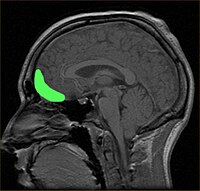
Photo from wikipedia
RationalePairing rewarding outcomes with audiovisual cues in simulated gambling games increases risky choice in both humans and rats. However, the cognitive mechanism through which this sensory enhancement biases decision-making is… Click to show full abstract
RationalePairing rewarding outcomes with audiovisual cues in simulated gambling games increases risky choice in both humans and rats. However, the cognitive mechanism through which this sensory enhancement biases decision-making is unknown.ObjectivesTo assess the computational mechanisms that promote risky choice during gambling, we applied a series of reinforcement learning models to a large dataset of choices acquired from rats as they each performed one of two variants of a rat gambling task (rGT), in which rewards on “win” trials were delivered either with or without salient audiovisual cues.MethodsWe used a sampling technique based on Markov chain Monte Carlo to obtain posterior estimates of model parameters for a series of RL models of increasing complexity, in order to assess the relative contribution of learning about positive and negative outcomes to the latent valuation of each choice option on the cued and uncued rGT.ResultsRats which develop a preference for the risky options on the rGT substantially down-weight the equivalent cost of the time-out punishments during these tasks. For each model tested, the reduction in learning from the negative time-outs correlated with the degree of risk preference in individual rats. We found no apparent relationship between risk preference and the parameters that govern learning from the positive rewards.ConclusionsThe emergence of risk-preferring choice on the rGT derives from a relative insensitivity to the cost of the time-out punishments, as opposed to a relative hypersensitivity to rewards. This hyposensitivity to punishment is more likely to be induced in individual rats by the addition of salient audiovisual cues to rewards delivered on win trials.
Journal Title: Psychopharmacology
Year Published: 2019
Link to full text (if available)
Share on Social Media: Sign Up to like & get
recommendations!